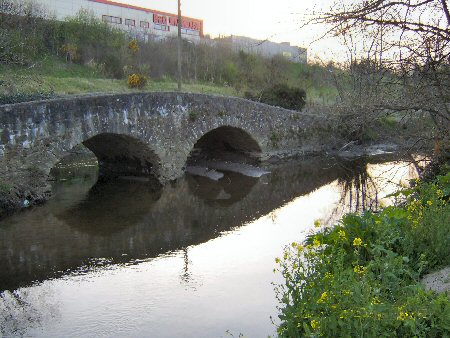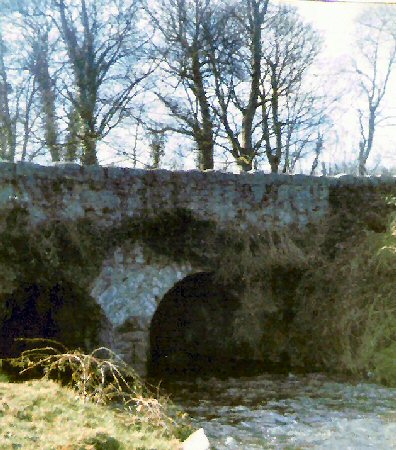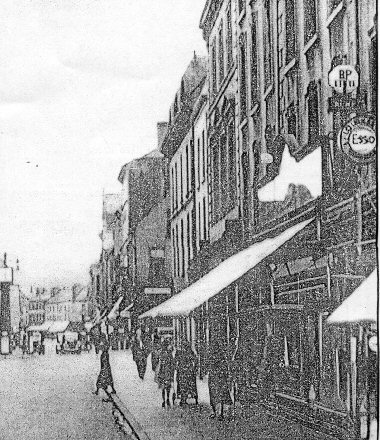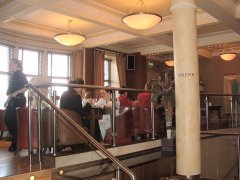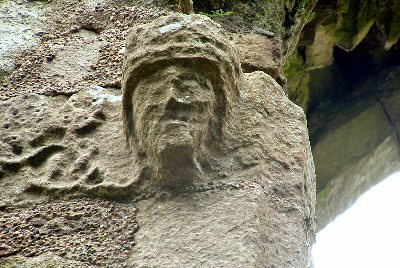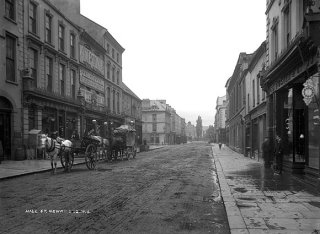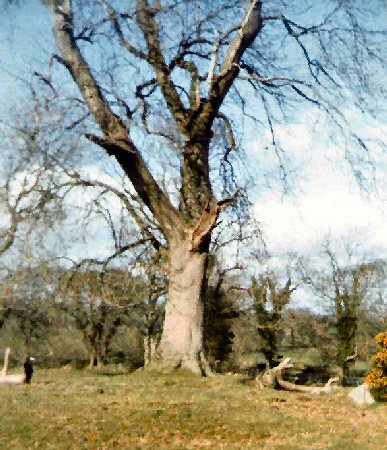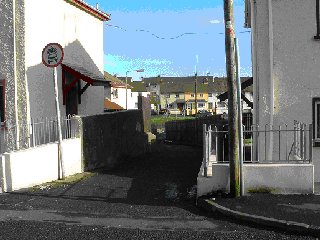Facing the phone-box, the first house on Orior Road whose garden abutted Fox’s, number 1 Slieve Gullion Road, was the Whites. Mrs White was a sister of Mrs Coffey [19] and so first cousins from Orior Road could play together. Next door was Peters, two sisters there, Patsy and Maureen being of an age with us as we grew up. Patsy later married Abbey teacher and traditional musician Johnny Watterson and I think for a time lived round the corner in Helen’s Terrace. Ruth Revels lived at number three, though there may have been another family before that.
Number four was the Ferris’s, one daughter from this family now works in Supervalu in Hill Street. [Since then it has been the McCaul’s]. Facing these houses, though with a Clanrye Avenue address were the homes of Nicky and John Barry [and sister?] with the McConvilles [Paul, Martin, two girls] next door. The flats on the corner were not occupied at first. Brian and Maura Donaghy had their home next to the Trundels facing the phone-box on Clanrye Avenue while going down towards ‘The Hut’ were the Quinns and another family, the Mooneys, including Joan and Oliver and a younger boy.
Round the corner, facing the entrance to the Pighall Loanan [hey, what a name!] and on Orior Road ‘ proper’ were the McCauls at number 5. Martin is an ambulance driver and lives near Jonesborough. He currently runs a Mastermind entertainment in Killeavy Community Centre on Saturday nights. Oliver has been noted herein as a Thompsons/Quinns driver some forty years ago [See ‘Round Square’ story]. Ann was a childhood companion and I’d still see her from time to time. She’s married and living out in Bessbrook.
Next door at number six was the Crimmins, Gerry (also a hospital worker) being our mate. (Before I forget, on Helen’s Terrace just yards away lived the Carraghers [Ann etc.] and Raffertys [Emmet, Francie] as well as Doyles, Bodels and McFaddens.
I recently received the following email from Godfrey Bodel in Freemantle, Western Australia!
“I am living in Australia now this past twenty-two years, but I spent eight years in Johannesburg, after emigrating from Ireland. Here is close enough to Paradise to end my wandering!
Hello to Patsy McGuigan and anyone else from Helen’s Terrace of the 1940s/1950s. It’s a long time since Rooney’s Meadow was just a field full of cows! “
Joe McGuigan of the Monaghan Street Shoe Shop, lived there for a time. His son Peter was our mate. Sadly Peter died tragically in his early adulthood. Patsy of the B&B, Downshire Road is an elder son].
Next then was the McGuigans. The father acted as sacristan in the hut that originally served as our first St Bridget’s Church, in the field presently serving as church property, but then also housing our first Meadow shop, at the top of Orior Road/Killeavey Road. Oldest boys in this family were Michael and Larry who now lives in Ballyholland and is a dance teacher. Pat [Sticks] Morgan’s house [8] was later was occupied by Junior McCoy. Sticks used to keep goats. He was a great man for the football, managing a team, Vincie thinks was called Pye’s Estate.
In 9 lived the McManus’s, relatives of the Ruddys. I remember Rose Ruddy, who, I think, was also a sister of Hugh John McConville’s wife. Johnny and Mrs McFerran originally lived above the Loanan in the house that was later to go to Councillor Tommy McGrath, but were re-allocated to a four-bedroom house a few doors down [10] because of their growing family. Patricia was the eldest girl [there was also a Kitty, now working at the hot food counter in Fiveways] and Richie the eldest of many boys. In 11, more recent occupants were the Rooney family, while Jim Mallon still lives in 12 with his mother. Jim recently retired from a teaching post in England.
Sean McGuigan [Vincent McAllister thinks they were cousins of the family that lived below them] lived at 13. He later taught in St Josephs and had a younger sister Gertrude, now better known as Trudi. Peter Jackson raised a large family at 14 Orior Road. Before that there were McSheas – Marie being a childhood friend of my informants Maureen and Eileen Drummond. The McMillens were in 15 and Tom Quinn lived, before the loanan at 16.
The Rocks’ [later to move to Derrybeg Drive – Brian, Bobby, Maureen, Rhoda etc.] originally lived along here, as did the Barrs [Jim, Eddie etc] who later moved to Iveagh Crescent. I think Tom Quinn later got their house, on the Loanan facing Tommy and Bridie McGrath [Bridie sadly, died just before Christmas].
Beyond Tommy McGrath’s were the Lucas’s. He had been a Welsh soldier, then worked as a postman. Patricia, Geraldine, Tony, Martin etc. [it was a large family] were our companions. The Coffeys, Brian, Derek etc. – already mentioned – lived next door. Cousins Eamon and Desie lived in Derrybeg Drive. Alison Coffey, Irish international golf star is a daughter of one of these early companions of ours.
Geoghans, an elderly couple who adopted Charlie lived in the last of this block of four and back-to-back with Vincent McAllister’s home on Slieve Gullion Road. This house was more recently occupied by the Carrs. Keenans lived at 21. The Goodwins [remember Charlie and Anne] who moved to Warrenpoint, lived here before them.
Eddie McVeigh, whose father was a bus-driver, lived next door. To the best of my knowledge, Mrs McVeigh still lives here at 22. Crawfords, Joan, Jack and Pete lived next. Joan was a good friend of Maura McAllister. Next door was the Smiths, Geraldine etc. who were cousins of Theo Patterson, three doors up.
The Drummonds – we knew Eileen, now married to Eddie Green and Maureen, married to Willie Rodgers and living on Killeavy Road – were in twenty five. Eileen married Eddie Green and they now have this house. Next door [26] was the Hollywoods, Bernie, Teddy etc. The next block began with the Pattersons, Theo, Mary, Patricia, Angela. Theo was best man at the marriage of Pamela and Vincent McAllister and later settled with his wife Tina [from Mayobridge] in Luton where Vincie worked and spent time with him.
Jack Shiels [28] was a tall man who worked on the railways – Arthur, his son, is tall too and still seen about town. Jack used to chase us around the gardens on our marathon game of Tig-Around-The-Block! Tina Griffin’s home was next. She married Jimmy Hutchinson and lives on Windmill Road. Her father Matt served for a long time on the committee of St Catherine’s Club. Peter Quinn lived next [30]: his father was a bus driver.
Then [31] it was the large family of Johnstons – many of them still about the town. We knew Bobby and Marie best. The McKeowns were next door, until they moved to Bradford in the late 50s. The house became the Boyles. Patricia now lives up the Rathfriland Road. The O’Hanlons lived – and still live – in number 33.
Next was the D’Arcys, Pat and Raymond the son. Terry and Mary McCartney lived next in 35: their father was a postman: Terry still works in the Post Office, Hill Street. Mary married and moved to England. The McGurgans [Oliver, Pat etc] lived in 36 – now I believe Micky Courtenay’s home. Way back, Robert McCaul [see Guestbook!] lived in 37 before emigrating to Australia in the 1960s. The Millars [cousins of Mrs McAllister] lived in the last house, number 38.
In the Horseshoe, at 39 lived the Fegans and next door the Pouchers. The Haugheys were in 41 [later Chris Coffey’s home, and later still Eamon McArdle]. Next door was Mallons, cattle-dealer and brother of Dr [Sunshine] Mallon. In 43 was the McSherrys and in 44 the Mathers. Crawfords had number 45 and the Byrnes were in 46. The Barrons lived in 47 and finally, another family of Byrnes had number 48.
It was remarked that a few other families occupied some of these homes in the early days. Mrs Lawless for example, in Keenans [relatives of Maura McGuigan?]. Vincie tells me he spent time in England with Tony Lucas working at EMI records in Hayes. Tony moved to Wales.
Vincie told me a story of a neighbour whom he suspected of nicking his eighth birthday present and damaging it before leaving it back. The man in question is now deceased, so we’ll leave well-enough alone. With his brother Eric, he remembers a Magowan funeral of the early fifties, where the glass-encased hearse was drawn by shire-horses complete with plumes. They were terrified!
